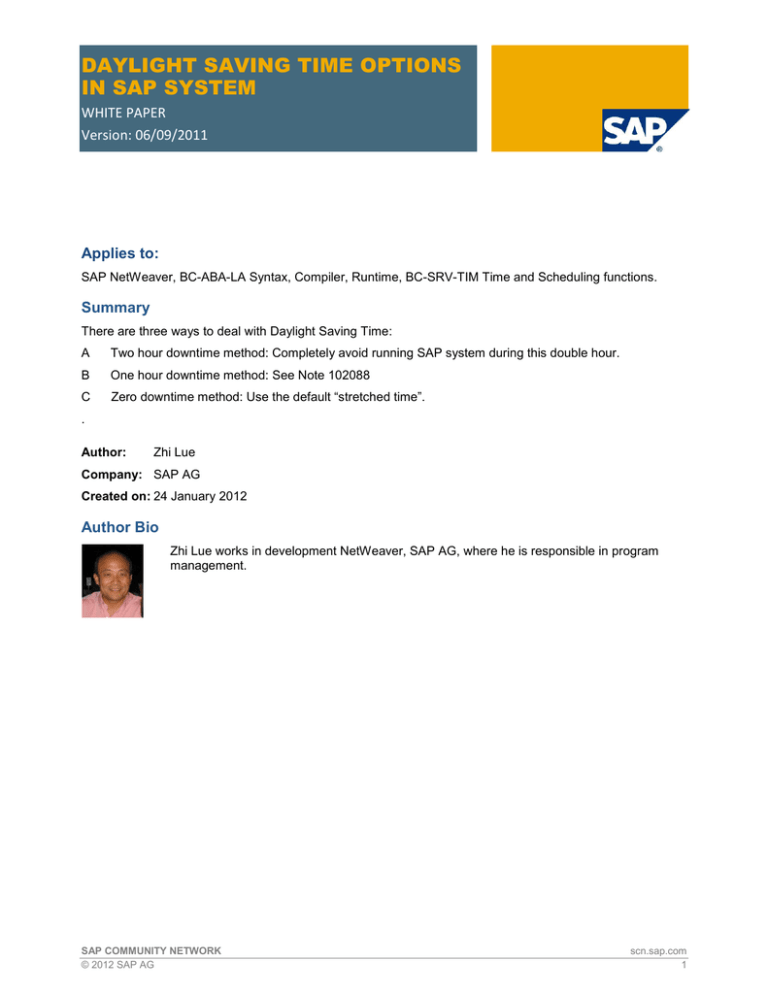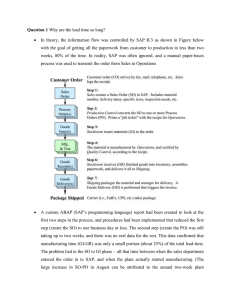
DAYLIGHT SAVING TIME OPTIONS
IN SAP SYSTEM
WHITE PAPER
Version: 06/09/2011
Applies to:
SAP NetWeaver, BC-ABA-LA Syntax, Compiler, Runtime, BC-SRV-TIM Time and Scheduling functions.
Summary
There are three ways to deal with Daylight Saving Time:
A
Two hour downtime method: Completely avoid running SAP system during this double hour.
B
One hour downtime method: See Note 102088
C
Zero downtime method: Use the default “stretched time”.
.
Author:
Zhi Lue
Company: SAP AG
Created on: 24 January 2012
Author Bio
Zhi Lue works in development NetWeaver, SAP AG, where he is responsible in program
management.
SAP COMMUNITY NETWORK
© 2012 SAP AG
scn.sap.com
1
Version: 06/09/2011
Table of Contents
What is the problem? .......................................................................................................................................... 3
Solutions ............................................................................................................................................................. 4
Information for the ABAP Developer .................................................................................................................. 5
Minor Defects: ................................................................................................................................................. 5
What Every ABAP Developer Should Do ........................................................................................................ 5
Class CL_ABAP_TSTMP may help ................................................................................................................ 5
Useful links for the ABAP Developer .................................................................................................................. 6
Related SAP Notes ............................................................................................................................................. 6
Copyright............................................................................................................................................................. 7
SAP COMMUNITY NETWORK
© 2012 SAP AG
scn.sap.com
2
Version: 06/09/2011
What is the problem?
For time zones with daylight saving time (DST), at the end of DST, you are required to move your clock one
hour backwards. For example, in Europe, on the last Sunday in October, the clock at DST 2:59:59 will be
reset in the next second to winter time 2:00:00. The hour running from 2:00:00 to 2:59:59 “on the wall” (local
time) will be run twice.
Like all the software that deal with local time will be confused when the computer clock traverses twice
through the same points in time, SAP system is no exception. With many delivered SAP systems, the
"system time", that is, "wall clock time", accessible via SY-UZEIT, SY-DATUM, is used for control-relevant
timestamps. With double hours this could lead to consistency problems. If, for example, timestamp1 is taken
at point 2:30 summer time and timestamp2 is taken at point 2:15 winter time, the timestamp comparison
timestamp1 > timestamp2
leads to an incorrect result.
These inconsistent records are stored in the database, and cannot be solved by system reboot.
Example:
We know, for example, that there is a problem with generating ABAP caused by the "double hours". A DDIC
object, which should be regenerated, may not be triggered.
Similar cases exist in APAP applications as well.
The first suggestion from SAP was, to shut down SAP system for the entire duration of the double hour, and
bring it up only after the double hour has passed. Thus, the SAP Kernel does not have to deal with any
possible mismatch of standard time and local time.
However, we know that many customers don’t do this. The inconsistencies that arose were solved by
support colleagues, presumably without ever having found out the real reason for them.
Therefore, SAP has invented the so-called "stretched time" method. Here, the system time is slowed down
the time by half, during the double hour, so that the 2 hour period is treated as one hour. The "double hour"
is in this case just one continuous half-speed hour.
"Stretched time" has the advantage that it is continuous and the inconsistency problems mentioned above
cannot occur.
But it has a disadvantage. It is not the correct time. It does not match the "wall clock time". Two types of error
can occur:
1. Applications that synchronize the stretched time with an external "wall clock time", eg
-by RFC in other systems (SAP or non-SAP)
-by data storage (file, DB, ...), which was filled by others (non-SAP) applications
2. Applications where the time must be correct, for example:
-Hospital: The time when a patient arrived at a hospital must be correct (a real example for a
hospital in Austria)
However, we have decided to make the "stretched time" the default. All customers have this setting, so that
the inconsistency problems no longer occur.
SAP COMMUNITY NETWORK
© 2012 SAP AG
scn.sap.com
3
Version: 06/09/2011
Solutions
There are three ways to deal with Daylight Saving Time. The method that you adopt will depend on your
specific environment well as your tolerance for system downtime.
A
Two hour downtime method: Completely avoid running SAP system during this double hour.
B
One hour downtime method: See Note 102088
C
Zero downtime method: Use the default “stretched time”.
For customers who choose the way A, a switch is provided to shut off the stretched time. For details please
see Note 102088.
As the "stretched time" is set as the default, all customers should decide for themselves whether they can
accept the disadvantages of the "stretched time". If they can, the system can continue to run.
If not, the customer needs to choose way either A or B.
Be aware of that, "stretched time" is first introduced since release 46C. For older releases there is no such a
choice.
How to code with “stretched time” by your own, so that it could run during the “double hours”, please see the
“Information for the ABAP Developer”.
We know of at least one example of an application which cannot work with the "stretched time":
Component "IS-H," SAP Patient Management (see customer message 0000298268 120 050 410 2005).
"Letting the “double hours” run first, and then dealing with any possible errors" is a rather risky approach.
Type 1) errors are not very likely to occur, but type 2) errors are almost certain to occur. You need to
analyze your situation exactly in order to choose the right method for you.
SAP COMMUNITY NETWORK
© 2012 SAP AG
scn.sap.com
4
Version: 06/09/2011
Information for the ABAP Developer
In general, most of the ABAP components should work with the retarded time model. In theory, there are
some cases where this may lead to problems. These cases are listed below.
Serious Problems:
Statically stored offsets of the system time to any other time not containing the retarded time model;
Comparison of time spans of system time stamps (retarded time) with UTC time stamps;
Transformations from UTC time stamps to system time stamps (retarded time) lead to the "wrong" results.
This should not happen very frequently, since the information about the system time zone is not easy to find
(table TTZCU);
Real time problems (statistics, timeout checks) ;
Comparisons of system times or time stamps (retarded time) and external local times:
Examples:
1. storing the difference between SY-TIMLO and SY-UZEIT and thinking it will remain constant.
2. comparing SY-UZEIT with times yielded from ABAP time zones:
a. using "GET TIME STAMP FIELD tstmp TIME ZONE anytimezone"
b. then converting time stamp "tstmp" to a date/time pair with "CONVERT TIME STAMP tstmp
INTO DATE date TIME time.".
c. Finally, calculating the difference between "time" and SY-UZEIT, thinking that it will remain
constant.
Minor Defects:
presentation of the system time (retarded time) to the user
selections within the system time (retarded time)
If you detect more problems like the above that may also affect other components please do not hesitate to
contact us.
What Every ABAP Developer Should Do
Please refer to the ToDo-List for the serious problems mentioned above.
After that you should consider whether the minor defects mentioned above might be relevant.
Class CL_ABAP_TSTMP may help
In the class CL_ABAP_TSTMP you will find a few static methods that may help you if you have encountered
problems in your project, that is.:
IsDoubleInterval:
Method to detect the "Double Interval"
SystemTstmp_Syst2Loc: Method to convert from retarded (system) time to local wall clock time
SystemTstmp_Loc2Syst: Method to convert from local wall clock time to retarded (system) time
SystemTstmp_UTC2Syst: Method to convert from UTC time to retarded (system) time
SystemTstmp_Syst2UTC: Method to convert from retarded (system) time to UTC time.
If you need even more functionality please do not hesitate to contact us.
SAP COMMUNITY NETWORK
© 2012 SAP AG
scn.sap.com
5
Version: 06/09/2011
Useful links for the ABAP Developer
NetWeaver doc: DST Safe Kernel (SAP Library - SAP High Availability)
Blogs:
SAP Network Blog: ABAP Geek 8 – Summertime (Blues) …
Wiki:
SAP CDT - DateTime
Code sample:
SAP Global Data Types Retrieval Tool
Related SAP Notes
Note 7417
- Conversion between winter time and daylight saving time
Note 102088 - Reducing downtime when changing from summer to winter time
Note 398374 - Problems when converting summer time <-> winter time
Note 950114 - Profile parameter zdate/DSTswitch_contloctime
Note 438660 - End of daylight-saving time coming soon, be ready!
SAP COMMUNITY NETWORK
© 2012 SAP AG
scn.sap.com
6
Version: 06/09/2011
Copyright
© Copyright 2012 SAP AG. All rights reserved.
No part of this publication may be reproduced or transmitted in any form or for any purpose without the express permission of SAP AG.
The information contained herein may be changed without prior notice.
Some software products marketed by SAP AG and its distributors contain proprietary software components of other software vendors.
Microsoft, Windows, Excel, Outlook, and PowerPoint are registered trademarks of Microsoft Corporation.
IBM, DB2, DB2 Universal Database, System i, System i5, System p, System p5, System x, System z, System z10, System z9, z10, z9,
iSeries, pSeries, xSeries, zSeries, eServer, z/VM, z/OS, i5/OS, S/390, OS/390, OS/400, AS/400, S/390 Parallel Enterprise Server,
PowerVM, Power Architecture, POWER6+, POWER6, POWER5+, POWER5, POWER, OpenPower, PowerPC, BatchPipes,
BladeCenter, System Storage, GPFS, HACMP, RETAIN, DB2 Connect, RACF, Redbooks, OS/2, Parallel Sysplex, MVS/ESA, AIX,
Intelligent Miner, WebSphere, Netfinity, Tivoli and Informix are trademarks or registered trademarks of IBM Corporation.
Linux is the registered trademark of Linus Torvalds in the U.S. and other countries.
Adobe, the Adobe logo, Acrobat, PostScript, and Reader are either trademarks or registered trademarks of Adobe Systems
Incorporated in the United States and/or other countries.
Oracle is a registered trademark of Oracle Corporation.
UNIX, X/Open, OSF/1, and Motif are registered trademarks of the Open Group.
Citrix, ICA, Program Neighborhood, MetaFrame, WinFrame, VideoFrame, and MultiWin are trademarks or registered trademarks of
Citrix Systems, Inc.
HTML, XML, XHTML and W3C are trademarks or registered trademarks of W3C®, World Wide Web Consortium, Massachusetts
Institute of Technology.
Java is a registered trademark of Oracle Corporation.
JavaScript is a registered trademark of Oracle Corporation, used under license for technology invented and implemented by Netscape.
SAP, R/3, SAP NetWeaver, Duet, PartnerEdge, ByDesign, SAP Business ByDesign, and other SAP products and services mentioned
herein as well as their respective logos are trademarks or registered trademarks of SAP AG in Germany and other countries.
Business Objects and the Business Objects logo, BusinessObjects, Crystal Reports, Crystal Decisions, Web Intelligence, Xcelsius, and
other Business Objects products and services mentioned herein as well as their respective logos are trademarks or registered
trademarks of Business Objects S.A. in the United States and in other countries. Business Objects is an SAP company.
All other product and service names mentioned are the trademarks of their respective companies. Data contained in this document
serves informational purposes only. National product specifications may vary.
These materials are subject to change without notice. These materials are provided by SAP AG and its affiliated companies ("SAP
Group") for informational purposes only, without representation or warranty of any kind, and SAP Group shall not be liable for errors or
omissions with respect to the materials. The only warranties for SAP Group products and services are those that are set forth in the
express warranty statements accompanying such products and services, if any. Nothing herein should be construed as constituting an
additional warranty.
SAP COMMUNITY NETWORK
© 2012 SAP AG
scn.sap.com
7




